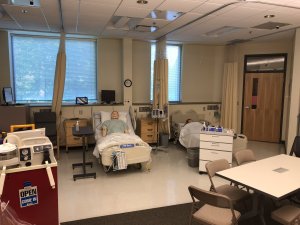The use of simulation in nursing education offers students a safe, controlled environment to experience simulated patient care experiences or to practice or be evaluated on nursing skills. Simulation is used here in our NMC simulation lab to connect classroom learning to clinical practice. It is a way we are able to reinforce and evaluate student skills before heading off to the clinical setting and caring for actual patients. A simulation experience can include the use of task trainers to simulate IV insertion, a standardized patient (human role play/ actor) used to practice assessments or communication skills, or high-fidelity manikins that respond to interventions in real time to simulate complex patient care scenarios. The simulation environment is also a great opportunity to integrate an electronic health record (EHR) and other health technologies (barcoding, pyxis, etc) for student familiarization.
Simulation can be utilized for evaluating learning outcomes of students. However, a strategic assessment plan should be discussed among faculty for consistency in evaluation. Simulation scenarios can provide the opportunity for student evaluation in the more critical patient management skills that are hard to replicate in the clinical experience, including: changes (or deterioration) of patient condition, teamwork, communication, and good safety practice. It is important to not place too “high stakes” on the simulation experience if it is to be used for evaluating student outcomes. Anxiety can override the experience, and therefore the learning. The reverse can be true if used for remediation of that shy or apprehensive student. Taking away the pressure and getting them comfortable, can translate to success in the clinical setting (and classroom).
It has been this author’s experience, as the nursing simulation coordinator here at NMC that simulation is bigger than just creating practice situations for students to experience. While Simulation can be a great way to showcase technology and innovation within a nursing program, one must consider that simulation is a tool, not a technology in itself. It is not just about expensive manikins, but creating something tangible for students to connect to their learning. The idea of simulation could easily be adapted to other subjects and classrooms to create a more meaningful (and yes experiential) learning experience.


